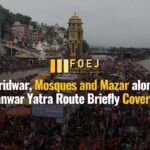A report jointly published by Oxfam India and Newslaundry named “Who tells our stories matters: Representation of Marginalised Caste Groups in Indian Media” showed that about 90% of leadership roles in TV, print media, and digital media are occupied by General Category groups with no representation of Scheduled Caste (SC) and Scheduled Tribe (ST) in the mainstream Indian media house.
“None of the mainstream media houses had people belonging to SC/ST categories in leadership roles,” the report said.
The report studied 190 samples from English and Hindi newspapers and television channels where it was observed that the Scheduled Caste, Scheduled Tribe, and Other Backward Classes were still under-represented in the Indian media.
90% of leadership positions in Indian media are occupied by Upper Caste groups with not even a single Dalit or Adivasi heading Indian mainstream media according to the report.
This was around 88% in 2019, showing negligible improvement. #IndiaWithoutDiscrimination pic.twitter.com/Bc93qJR6ou
— Oxfam India (@OxfamIndia) October 14, 2022This report took into account 43 Indian newspapers, TV channels, and digital media houses. The study was published after a meticulous study by the researchers, taking into account more than 20,000 magazines and articles, 2,075 debates prime-time hosted by 76 anchors including 3,318 panellists along with 12 months of online reports between the period April 2021- March 2022.
It was based on qualitative parameters like the social location of the authors, prominence of the news item and subject of the coverage by the news channel. The study also researched the representation of different caste groups among the working staff of news media houses using surveys, secondary sources and databases from UPSC and central universities.
Among 40 anchors from Hindi News Channels and 47 from English, out of every four anchors in debates, three were from the upper caste category.
“For over 70 per cent of their primetime debate shows, news channels draw the majority of the panellists from the upper castes. No more than 5 percent of all articles in English newspapers are written by Dalits and Adivasis. Hindi newspapers fare slightly better at around 10 per cent,” the report said.
It also showed that out of every 5 articles written in both English and Hindi newspapers, 3 of them are written by General category people while the marginalized groups contribute to only 1 article out of those 5.
There was a marginal improvement in the total representation of Scheduled Castes, Scheduled Tribes, and Other Backward Classes. In 2019, the overall representation of the General Category was 88% for journalists. This year it was 86%.
The researchers studied 14 English and Hindi newspapers and found that the organizations were unable to employ journalists from the SC and ST groups to cover issues related to their communities.
The CEO of Oxfam India, Amitabh Behar, remarked that the report demonstrated the failure of Indian newsrooms as they are not “an inclusive place for marginalised communities in the country.”
He further said that the constitutional belief of equality should be followed in the media houses- not just in the coverage of issues related to people of marginalized communities but also in its “hiring practices.” Behar said that the leader of these organisations “continue to fail” in creating an enabling environment for “Dalits, Adivasis and Bahujans.”
“It is critical that media organisations immediately conduct a significant overhaul of hiring practices and ensure that newsrooms across the country become more diverse and inclusive. This would be crucial for creating India without discrimination and injustice,” he said.









